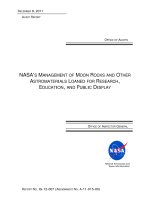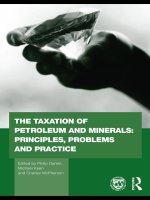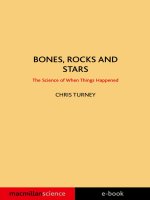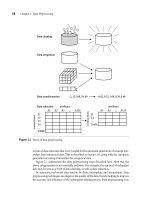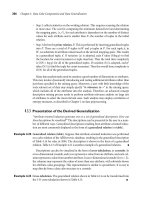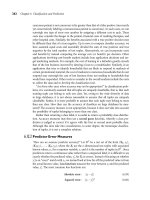- Trang chủ >>
- THPT Quốc Gia >>
- Hóa
Mining rocks and minerals
Bạn đang xem bản rút gọn của tài liệu. Xem và tải ngay bản đầy đủ của tài liệu tại đây (5.35 MB, 14 trang )
Earth Sciences
by Donna J. Watson
Genre
Nonfiction
Comprehension Skill
Compare and
Contrast
Text Features
•
•
•
•
Captions
Labels
Diagrams
Glossary
Science Content
Rocks and
Minerals
Scott Foresman Science 4.6
ISBN 0-328-23558-X
ì<(sk$m)=cdf ic< +^-Ä-U-Ä-U
Vocabulary
Extended Vocabulary
cleavage
igneous
luster
metamorphic
mineral
ore
rock cycle
sedimentary
streak
adit
anthracite
bituminous
bronze
kimberlite
lignite
overburden
room-and-pillar
smelting
by Donna J. Watson
Picture Credits
Every effort has been made to secure permission and provide appropriate credit for photographic material. The
publisher deeply regrets any omission and pledges to correct errors called to its attention in subsequent editions.
Unless otherwise acknowledged, all photographs are the copyright of Dorling Kindersley, a division of Pearson.
Photo locators denoted as follows: Top (T), Center (C), Bottom (B), Left (L), Right (R), Background (Bkgd).
Opener: Russell Gordon/©Aurora Photos; 3 (BR) Richard M. Busch; 4 Lauros/Giraudon/Bridgeman Art Library; 5 Erich
Lessing/Art Resource, NY; 6 (B) Mary Evans Picture Library, (Inset) Erich Lessing/Art Resource, NY; 7 Erich Lessing/Art
Resource, NY; 8 (B) Roger Ressmeyer/Corbis; 10 (Bkgd) Getty Images; 11 (Inset) Albert Copley/Visuals Unlimited;
12 Jason Lewis/DK Images; 16 (BL) Kaj R.Svensson/Photo Researchers, Inc., (BR) Photo Researchers, Inc.; 17 (T) Theodore
Voget/Photo Researchers, Inc.; 19 (T) Charles O’Rear/Corbis, (B) Peter Essick/©Aurora Photos; 20 (Bkgd) AFP/Getty
Images; 21 (Inset) Russell Gordon/©Aurora Photos; 22 (Bkgd) William Campbell/Peter Arnold, Inc.; 23 (Inset) Inga
Spence/Visuals Unlimited.
ISBN: 0-328-23558-X
Copyright © Pearson Education, Inc. All Rights Reserved. Printed in the United States of America.
This publication is protected by Copyright, and permission should be obtained from the publisher prior to any
prohibited reproduction, storage in a retrieval system, or transmission in any form by any means, electronic,
mechanical, photocopying, recording, or likewise. For information regarding permission(s), write to
Permissions Department, Scott Foresman, 1900 East Lake Avenue, Glenview, Illinois 60025.
1 2 3 4 5 6 7 8 9 10 V010 13 12 11 10 09 08 07 06
What You Already Know
A mineral is a natural, nonliving, solid crystal that makes
up rocks. All rocks are made from minerals. Most rocks are
made up of combinations of different minerals. There are
thousands of different minerals, but most rocks are made up
of only a few of them. Each sample of the same type of rock
always has the same minerals.
You can identify a mineral by testing its properties. A
mineral’s propreties include color, luster, hardness, streak,
cleavage, and crystal shape.
Streak is the color of a rock’s powder when the rock
is scratched across a special plate. The Mohs scale ranks
a mineral’s hardness. Luster is the property of how a
mineral reflects light. Minerals that break along smooth, flat
surfaces have cleavage. Finally, a mineral’s crystal shape can
sometimes help identify it.
2
A rock that contains valuable minerals is an ore. There
are three different types of rocks: igneous, sedimentary, and
metamorphic.
Igneous rock is rock that forms when magma or lava
hardens. Sedimentary rock forms from layers of soil, bits of
rock, shells, and dead plant and animal matter that press on
each other for years and years. Metamorphic rock is rock that
has been changed by heat and pressure.
Rocks are in a continuous process of being formed,
destroyed, and formed again. This process is called the rock
cycle.
In this book you will learn about the rocks and minerals
that people have mined and continue to mine. Different
people have been mining for thousands of years in different
parts of the world. Keep reading to find out more!
3
Mining in the Past
People have been using rocks and minerals as resources
for thousands of years. The term Stone Age describes the time
period when humans first started using rocks and minerals
as simple tools. At first, people just used what they found on
the ground around them. The Stone Age began as early as
700,000 years ago in some parts of the world. It lasted until
about ten thousand years ago.
In the Stone Age, most mining was for flint. Flint has
several properties that made it valuable to Stone Age people.
People could make good tools and sharp weapons from it.
Flint also chips easily, which made it easy for people to shape
and rework. And flint can be used to help start fires.
Stone Age people discovered flint in beds of chalk buried
underground. They used deer antlers, stone tools, and tools
shaped from animal bones to dig it up.
These Stone Age tools, discovered
in France, are made of flint.
4
The Copper Age
Copper was the first metal to be mined in large amounts
in many parts of the world. People first created objects out
of copper about eight thousand years ago. The ancient
Egyptians were some of the first people to mine copper.
Copper mining slowly spread northwest through Europe.
People living in Germany and parts of southeastern Europe
began mining copper about five thousand years ago.
Copper proved to be better than flint. It is soft and easily
shaped. It becomes hard after it is hammered. But copper is
rarely found it in its pure form. Arsenic, tin, and antimony
are often mixed in with copper ores. Smelting, the process of
melting away unwanted substances from metal ores, began
soon after copper mining started. When people started
smelting copper ores to make bronze, a mixture of copper and
tin, the Bronze Age began.
This tomb painting from ancient Egyptian
times shows workers smelting copper.
5
The Bronze Age
The Iron Age
As early as five thousand years ago, people in parts of
Turkey were mining tin in order to make bronze. Around that
time, Israel’s Timna Valley became a center of Bronze Age
mining and smelting. Copper miners at Timna dug with stone
tools to get at ore that was underground. In Faynan, Jordan,
copper miners working about four thousand years ago mined
as deep as 20 meters below the ground.
By a little over four thousand years ago, people throughout
the world were making bronze. Just as copper was better than
flint, bronze was stronger than tin or copper alone. Bronze can
be poured into casts, or special shapes, after it is melted. It also
becomes very hard when it cools. Such discoveries led people
to experiment with mixing metals other than tin and copper,
such as silver, lead, zinc, and mercury.
Hematite is a mineral that contains iron. Scientists believe
that over 40,000 years ago, people in Swaziland dug it from
a cave to make dyes. Seven thousand years ago, in parts of
England, people were digging iron from the ground. And
scientists think that a little over four thousand years ago
people in Turkey washed beach sands to remove iron from
them. The iron was then sent to furnaces to be smelted.
Of iron, flint, copper, and bronze, iron is the strongest. So
people switched to working with iron. This change marked
the beginning of the Iron Age. By three thousand years ago,
iron smelting had begun in many parts of the world. Some
might say that we are still living in the Iron Age. Modern
steel, for example, is a combination of iron and carbon.
Bronze Age metalworkers (below left)
made spearheads (below right) from
copper and other metals.
6
Here you see a reconstruction of
an iron smelting forge from two
thousand years ago.
7
Mining Today
Today most rocks and minerals are mined from far
underground. How do miners and geologists find them?
Geologists often start by making a geologic map of an
area. They look for faults and other features in Earth’s crust.
When geologists find sedimentary rocks of a certain age, they
can sometimes tell what minerals may have formed them.
Geologists use different tools to find rocks and minerals.
They use Geiger counters to detect radioactive substances,
such as uranium. They use gravimeters to show the density of
different rocks. Magnetic ores are found using magnetometers.
Geologists drill sample cores or trenches to bring up dirt
and rocks from an area. They study the samples to determine
how deep a mine should go. Engineers then use computers to
design the best mine for that location and mineral type.
Engineers study many features of an area before choosing
the type of mine needed. They study the soil on the surface,
along with the overburden, or unusable rock. This material
must be taken away before miners can get at the valuable ore.
They also consider the amount of groundwater there, and
how water will drain from the mine. Finally, the engineers
must decide what materials are needed to build the mine, and
how the mine will be supplied with fresh air.
Along with the engineers’ studies, geologists try to figure
out the grade, or quality, of the ore that will be mined. They
estimate the quantity of ore that is there, and the milling, or
processing, needed before the minerals can be sold. Once a
mining company decides to build a mine, they need to choose
whether to build a surface mine or an underground mine.
Today’s miners use heavy
machinery to dig out ores.
These geologists are taking
samples from rocks.
8
9
Types of Mines
People have developed several types of mines since mining
began. The first mines that people dug were surface mines.
Surface mines are the least expensive mines to build. But
digging them can cause a huge amount of damage to the land.
Miners have to cut down trees and scrape off grass, shrubs,
and topsoil. Then they must remove the top layers of rock to
reach the ore that is below. Today the topsoil and top layers
of rocks are saved and then replaced once the surface mine
has been used up. But in the past, once miners were done
mining a surface mine, they would just leave it as it was.
Miners working at this coal mine
have removed trees, plants, and soil
to get at coal far below the surface.
More Surface Mining
Open-pit mining and strip mining are two of the most
common types of surface mining. Often a machine called
a crusher will be built at the site of an open-pit mine. The
crusher crushes the ore taken from the mine. The ore is then
taken to a nearby processing plant to be heated. The heating
removes the valuable minerals from the crushed ore.
Quarrying is another term for open-pit mining that is done
close to the surface. Quarries are dug to remove rocks that do
not need to be processed. Granite is often removed in large
blocks from a quarry. Gravel and sand are also quarried.
Placer mining, which is when minerals are removed from
the sediments found on river bottoms, is another type of
surface mining. Placer mining is especially useful for mining
gold, and was widely used during the California gold rush.
A granite quarry
10
11
Underground Mines
Underground mining is usually more expensive than
surface mining. This is because underground mines need
entrances to get to the ore and passages to remove it.
An adit is a horizontal,
ground-level tunnel into
a hill or mountain. It is a
type of mine. A shaft is a
vertical tunnel that goes
straight down into an
underground mine.
Miners often break up
the rocks in underground
mines by blasting them
with dynamite. They put
the broken-up rock into
buckets or on elevators or
conveyors to move it to the
surface. As the ore is removed,
supports are built to keep
the mine from collapsing.
Sometimes small railways are
built to transport the ore from one
end of a tunnel to a conveyor. The
conveyor then takes the ore to the surface.
Underground coal mines are often built using a method
called room-and-pillar. The coal is removed from certain
areas, but pillars of coal are left behind to support the mine’s
roof. Because of the value of the coal, a room-and-pillar mine
can later be turned into a special kind of mine called a retreat
mine. In a retreat mine, the pillars are removed, causing parts
of the mine’s roof to collapse. You might think that these
collapses would be a danger to the miners. But the miners do
not have to leave the mine while the collapses are happening.
Another type of underground mining involves drilling
holes called boreholes. Miners drill boreholes into an ore.
Using high-pressure hoses, they blast the ore with water. The
water breaks up the mineral and mixes with it. Miners pump
the mixture to a tank on the surface. The minerals settle at the
bottom of the tank. The water is pumped back into the mine.
A modern underground mine
This diagram shows
how an underground
mine changes the land.
12
13
Mining in
the United States
Mining in the United States is a big business. According
to the National Mining Association (NMA), in 2003 there
were about 14,300 working mines in the United States. At the
time, those mines employed about 320,000 people. The coal,
metals, and minerals dug from underground in 2003 by mines
in the United States were worth a total of $57 billion.
Ranked in order, the top five coal mining states in 2003
were Wyoming, West Virginia, Kentucky, Pennsylvania, and
Texas. The top five mineral producing states that year were
California, Nevada, Arizona, Texas, and Florida.
Gold Rush!
There have been four major mining “rushes” in recent
North American history. There was the California gold rush
of 1848-1849, the Colorado gold rush of 1858-1859, the
discovery of silver in northern Nevada in 1859, and the 18961900 gold rush in Canada’s Yukon Territory. Of these rushes,
the California gold rush is the most famous. On January 24,
1848, John Marshall found gold on California’s American
River. News of the find spread rapidly. By 1849, thousands of
people were flooding into California seeking gold.
At first, the miners panned for gold directly out of rivers.
When that gold was removed, the miners dammed the rivers.
The damming left streambeds dry, allowing miners to get at
harder-to-reach gold. In the early 1850s, the miners started
blasting the streambeds with water from hoses. This wrecked
river environments, but helped the miners locate more gold.
These California gold
rush miners are using
a type of placer mining.
14
15
Mining Coal
In 2003, coal made up one-third of the value of all
minerals mined in the United States. About two thousand
coal mines in the United States were active that year. This was
about one-seventh of all mines in the United States.
The amount of pressure placed on coal determines its
grade. There are four grades of coal. The highest grade of
coal is anthracite. Anthracite coal burns cleaner and contains
more energy than other coals. Bituminous coal, often referred
to as soft coal, is the grade below anthracite. Subbituminous
coal has a dull black color. It has significantly less energy than
bituminous or anthracite. Finally, there is lignite coal. Lignite
coal takes less time to form than the other three grades, but
contains less energy.
Coal was first mined in California in 1855. Coal
production stopped in the mid-1900s when oil and gas were
discovered in the state. It began again in the 1980s because of
California’s unique lignite coal. Lignite mined in California’s
Amador County contains montan wax, a wax from certain
fossil plants. This type of lignite is rare, but important for
industrial use.
anthracite coal
16
bituminous coal
17
Mining Diamond
Coal and diamond have very different properties.
Diamond is always arranged in a crystal structure. The
structure of coal varies. Diamond is the hardest known
substance. Coal is much softer. Coal is usually black in color,
but diamond is almost see-through. Despite these differences,
coal and diamond are both formed from carbon.
Very few diamonds have ever been found in the United
States. The world’s leading producers of diamonds are South
Africa, Canada, Australia, Russia, and Botswana. Diamond is
found in kimberlite, a heavy and dark type of igneous rock
that forms pipes deep beneath the ground.
Miners mine for diamonds by digging shafts close to
kimberlite pipes. Then they dig tunnels from the shafts to the
pipes and build elevators. The elevators move the kimberlite
to the surface, where it is processed.
Diamonds that are found on the seafloor are brought to
the surface using a large hose connected to a barge. The hose
works like a vacuum cleaner to suck up gravel that contains
diamonds.
The diamond on the left has
been cut and worked on. The
diamond below is trapped in
a rock.
18
19
Mining Gold and Silver
In spite of the amount of gold and silver taken out of the
ground during different rushes, there is still a lot that has
yet to be found in the United States. The gold mined in the
United States in 2003 was worth $3 billion. Most of this gold
came from Nevada. The silver mined that year in the United
States was valued at about $180 million.
Gold mines have been dug thousands of meters deep to
get at gold deposits. One shaft in a gold mine in South Africa
descends nearly four thousand meters below the surface!
Some gold is removed from ores by smelting them. At
other times, mercury, which combines with gold, is used to
pull gold out of ore. Cyanide is also used to remove gold from
ore by dissolving the gold. The mixture of gold and cyanide is
then treated with zinc to remove the gold.
20
People often think of silver and gold as being linked
because both metals have been used throughout history
as money. Silver mining goes back thousands of years. An
important difference between silver and gold is that silver
is often found in other minerals. During the Bronze Age,
metalworkers smelted lead ores to get silver. Silver can also be
smelted from copper and zinc ores.
A method called flotation separation is often used to
remove silver from its ore. Flotation separation is now the
most commonly used way of removing mineral from ore.
In this method, the ore is mixed with water and special
chemicals that repel silver from water. The silver then attaches
to air bubbles in the water, and floats to the surface of the
mixture. When it gets to the surface, it is removed.
These miners are
working in a silver
mine in Argentina.
21
When a Mine Closes
What happens when a layer of ore that is being mined
stops or gives out? In most cases, the mine has to close. When
no more valuable minerals can be found to sell, an owner
cannot keep removing rocks that have little value.
As chemists have learned new methods for separating
metals from ore, mining has become profitable again at
some old mines. Mining companies also use new methods to
separate minerals from ore they have already processed.
If a mine is never going to be opened again, people now
expect the miners to restore the land to its original look. To
do this, engineers work to control how the land around the
mine drains, in order to prevent water pollution and the land
from settling. They reseed native plants, and restore streams,
rivers, and wetlands that have been affected by mining.
22
Mining will always be controversial because it can
damage the environment. Scientists have found better ways to
clean up the messes some mines have caused. This includes
preventing toxic chemicals from seeping into the ground and
water near a mine.
Many old mines in different parts of the world have
polluted the surrounding environment as substances have
leaked out of them. Unfortunately, cleaning up old mines can
be very costly. One challenge for the future will be to find new
ways to safely and cheaply operate mines.
This California creek has been polluted
by acidic water from a mine.
23
Glossary
What did you learn?
1. What are the four different types of coal?
adit
a type of mine that is a horizontal,
ground-level entrance to a hill or mountain
anthracite
the highest grade of coal, it contains the
most energy and takes the longest time
to form
bituminous
the grade of coal beneath anthracite
bronze
a mixture of copper and tin, made by
smelting
kimberlite
a heavy and dark kind of igneous rock that
contains diamond
lignite
the lowest grade of coal, it takes the least
time to form but contains the lowest
amount of energy
overburden
the unusable rock that must be removed to
get at a valuable ore
room-and-pillar a type of underground mine where rooms
are created by leaving behind pillars of ore
smelting
24
the process of melting metal ores to
remove unwanted substances
2. What tools did Stone Age peoples use to dig for flint?
3. What type of mine is dug to remove rocks that do not need
processing?
4.
Summarize what happened during
the California gold rush.
5.
Compare and Contrast Compare and contrast diamond
and coal.
